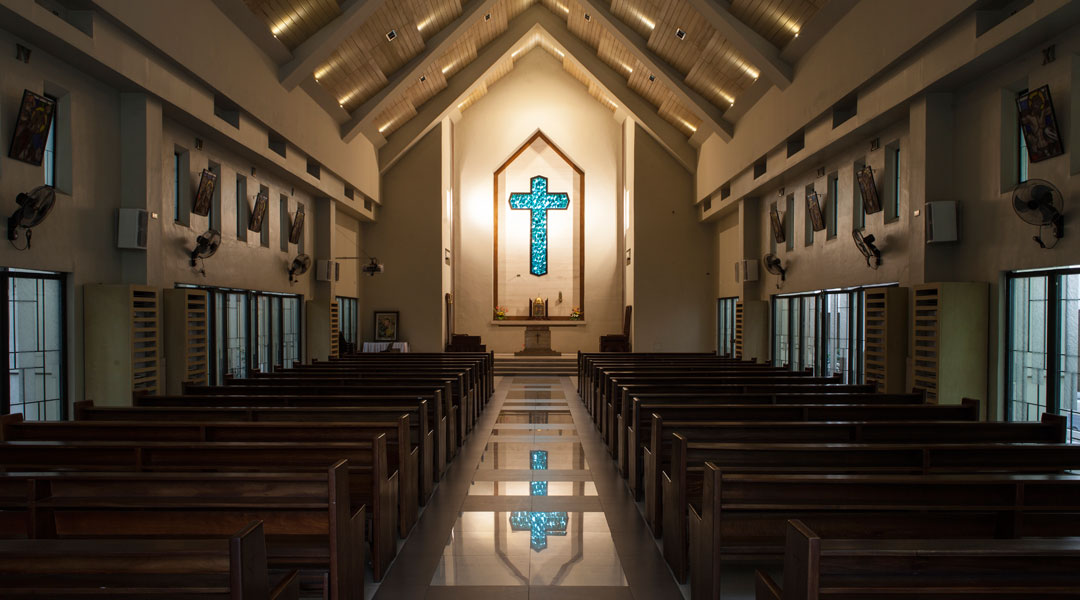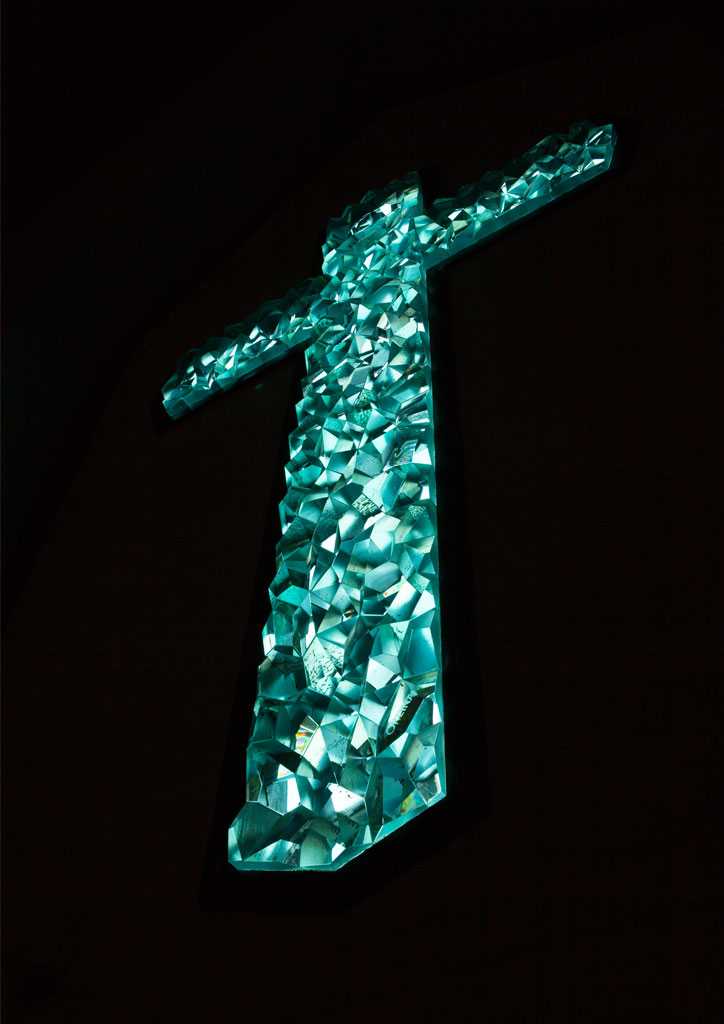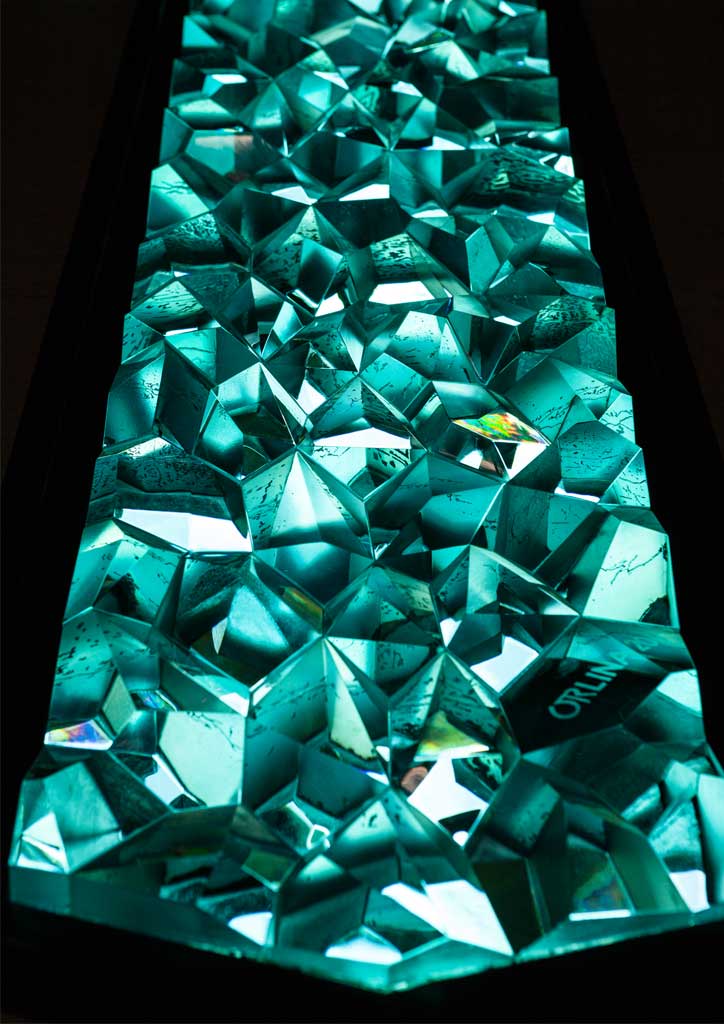
Ramon Orlina carves 150 glass pieces for Trinity Chapel’s altarpiece
We were told to wait for something special, especially when the skies are clear, much like the day we visited the Trinity University of Asia (TUA) Chapel in Quezon City. The chapel welcomed us with gentle steps, open doors, and a blue-green glow at the end of the marble and onyx altar arrested our attention and reminded us this is the Lord’s house.
One hundred fifty carved glass pieces make up the cross embedded in the altar wall, filtering sunlight from its east-facing rear. It was marvelous as it was, leaving one to wonder if this was already the awaited spectacle.

Construction of the chapel began in 2008, conceptualization as early as 2004. Under the leadership of then university president Dr. Josefina Sumaya, Trustee Jerry Navarete, and Engr. Rydyl M. Obsum, the university’s Building Adminstration and Maintenance Office envisioned a long lasting statement of faith and thanksgiving Trinitians would be proud of.
More than one study for the altar was produced until Dr. Sumaya thought of commissioning a renowned Filipino artist for the altarpiece, which was installed in September 2011. Ramon Orlina, with his characteristic slicked hair, arrived at the chapel, took his own photos of the cross, and sat down on the second pew to tell us about it. He spent six months to complete the cross in his studio carefully installing each fragment, which went through cutting, grinding, smoothing, and polishing before fitting in the metal frame.

There was no prior schema for the location of each piece. Ramon Orlina simply cut chinks of glass into faceted forms that would fit as the construction progressed. His studio team worked on the three process after it. Bottom to top, the 11.5 by 7 feet frame was filled with glass fragments varying 6 to 8 inches thick. The sculpture then was transported to the university grounds for installation.
Upon closer inspection, protrusions cover the cross’ surface, like turquoise mountain ranges made of glass. He explained that adjacent fragments needed to ‘diverge’ in order to avoid casting shadows on one another, a technique similar to fill in what used to be a stained-glass window in their building.
READ MORE: The smaller and atypical Bacolod churches and chapels representative of the passionate Negrenses
In between colorful narratives of his days in architecture school, his ancestral home in Taal, and his disdain for the parish officials there for attaching incompatible structures to Taal’s heritage church, the sculptor shared why glass appeals to him so much. It collects light. “‘Yon ‘yong kagandahan ng structure ng glass, it can absorb. It can reflect. It can refract. Ika nga, prismatic. And I can use it outside,” Ramon Orlina said. Prism; this hinted at the expected effects of the sculpture.
An exploration of the chapel grounds led us to discover a tree flourishing right behind the chapel, preventing sunlight from directly hitting the cross. As with the front, the rear of the cross exposes multiple parts in varying shapes and slopes. Thus, no matter what hour of the morning, if the trajectory were free of branches, there will glass surfaces angled in just the right way to catch the sunlight.
If anything, the sculpture is a metaphor for how the Church is composed of people receiving, in varying capacities, the Christian message which reaches its pinnacle in the cross. And when the morning light—a symbol of hope and goodness—overflows, changes can be seen in the surroundings. Orlina fittingly named this piece, “The Light of Christ.”


The university administration told us the cross was cleaned every week. When asked about plans for the tree thriving behind the chapel, Engineer Obsum replied, “That reminds me! From time to time, we need to prune the branches. But for nighttime, may backlight kaming nilagay to focus on the cross.” Hopefully, some pruning happens soon.
After visiting the Building Administration and Maintenance Office, we took one last look at the chapel. The lighting and fans were now off. At the end of the nave, there they were: kaleidoscope specks scattered on the walls and floor until where the artist sat earlier. After a few minutes, they disappeared. It felt like grace or, at least, something like it. ![]()
Original article first appeared in BluPrint Vol 2 2017. Edits were made for BluPrint online.


